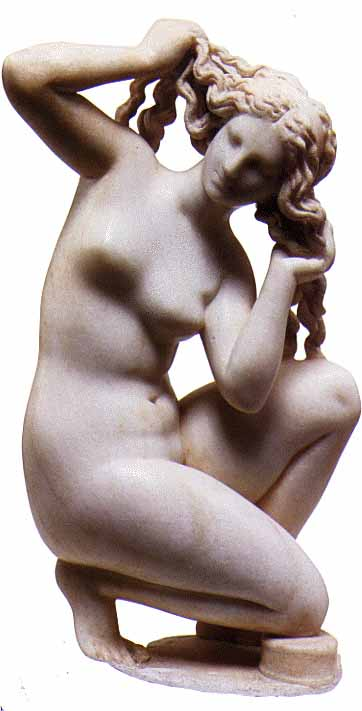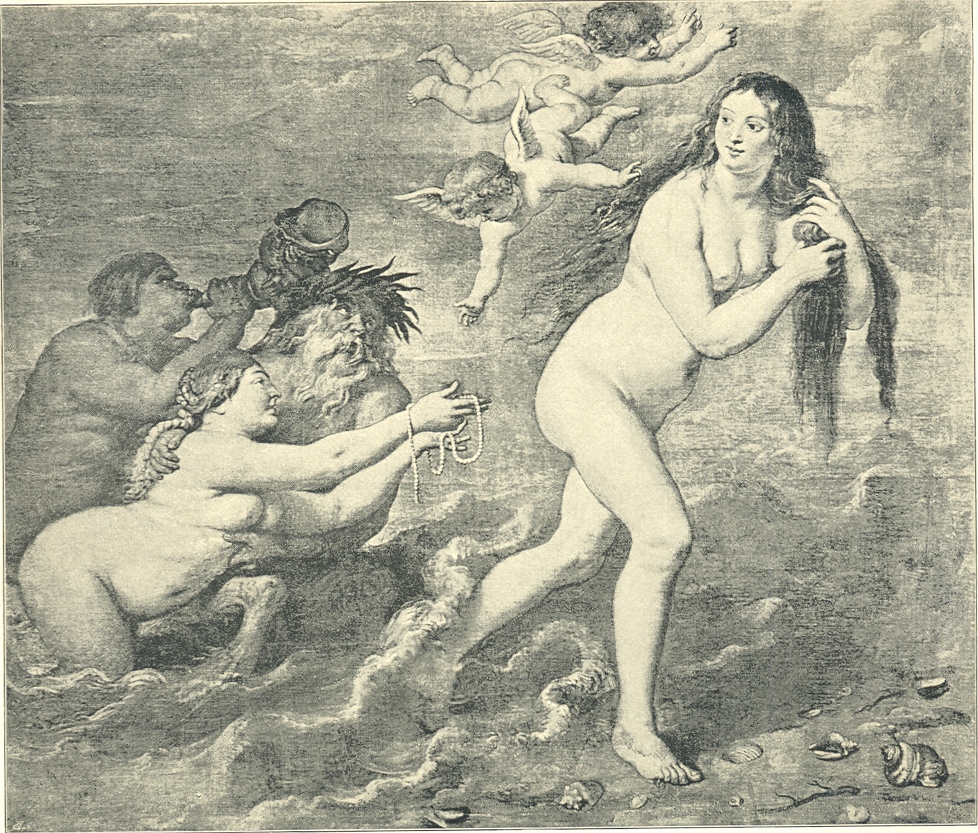金星の庭園に戻ろう(2)
ダービー・コステロ著 咲耶まゆみ訳 By Darby Costello Translated by Mayumi Sakuya
English text to follow.
Birth of Venus W.H. Goss c1870.
白い泡が不死の肉体を包む。
泡の中で生まれる乙女。
愛らしい女神現れ、この上なく崇められる。
人々や神々は、女神をアフロディーテと呼ぶ。
女神のお供はエロス。欲望の神。
誕生から女神の後に従う。
彼女はこの栄誉を授かり、権力を手にする。
優しくささやき合う娘たち。微笑み、いたずら。
そして甘露な喜び、人なつこさ、愛らしさ。
この女神は、メソポタミア時代の星の女神イナンナとイシュタル、そして東洋の女神からさえも特徴を受け継いでいる。しかし、ギリシャのアフロディーテは、他にはない独自性も持つ。父親殺しの記憶を持つ海の泡から誕生したのだ。そして、「もはや、宇宙の力ではなく、斬新で独特な『歓喜の女神』になった」。
Venus Anadymomène Cornelis de Vos 1585-1651 Prado, Madrid
この時代からアフロディーテを通して、生きとし生けるもの同士が互いに感じ合い、自然に引き寄せ合う力を象徴する美が、一つの形として形成されていった。
それぞれのパーツに独自の性格と生命を与えるために、宇宙の鎖を解きほぐしていくようなギリシャ流のやり方で、アフロディーテは分離され、彼女独自の世界を与えられた。それが「愛の美」の瞬間だ。
アフロディーテは「愛の抱擁による歓喜」を体現する。この女神は、創造性を秘めた者同士が出会ったときに経験する時代を超えた喜びだ。2人の生きとし生きる者(人、牛、魚、植物でさえも)が創造の可能性を持った時に、女神はそこにいた。
その美の中に女神はいた。彼女はその中にある喜びなのだ。
数世紀後、ギリシャ人が宇宙の性質を理解するために、新しく、複雑なパターンを作っていた頃、哲学者で詩人のエンペドクレス(紀元前490年頃 – 紀元前430年頃)は、「愛」と「不和」は創造の2大基本性質であると言及した。彼は地球がどのようにして「アフロディーテのための完璧な隠れ家」として定着していきながら他の様々なものと融合していき、血肉を作ったかについて詳述している。
エンペドクレスいわく、アフロディーテは、火・地・風・水の混合によって誕生した死ぬ運命にある形や色全てに整合する。この女神は女王であり、人に愛について考えさせ、平和へ向かわせた。彼女は死すべきものの中に埋め込まれ、「歓喜」と呼ばれた。そしてアフロディーテの愛の中で物事は一つになった。何と素晴らしいイメージだろう!
このような喜びのひと時は、素早く通り過ぎる。宵・明けの明星の美しさが通り過ぎるように。朝が始まる直前と、夜が戻る直前のように。ギリシャ人は日中の厳しい現実と夜の暗闇の危険の間にある、これらのはかない美のひと時を神聖なものと見た。アフロディーテは、これらの神秘、はかなさ、退色の瞬間、そして夕暮れと夜明けの間に長い間姿を消すことさえも体現していた。女神は、はかなく、つかの間の一時の喜びだった。
「金星の庭園に戻ろう(3)」続く
Recovering the Garden of Venus (2)
Birth of Venus W.H. Goss c1870.
White foam surrounded the immortal flesh,
And in it grew a girl… The goddess came forth,
lovely much revered…
Her name is Aphrodite among men
And gods…
Eros is her companion; fair Desire
Followed her from the first…
She has this honour and received this power:
Fond murmuring of girls, and smiles, and tricks,
And sweet delight, and friendliness, and charm. *3
This goddess had absorbed characteristics from the earlier Mesopotamian star deities, Inanna and Ishtar, and even from Oriental goddesses, but here in Greece Aphrodite became something unique: she who arose out of the swirling sea with its foaming memory of patricide, was ‘no longer a cosmic power but a something new and particular, ‘the goddess of rapture.’ *4
Venus Anadymomène Cornelis de Vos 1585-1651 Prado, Madrid
It was from this time, through Aphrodite, that the beauty that illuminates the natural attraction that living beings have for each other was given shape and form and a life of its own. In the Greek way of teasing apart the strands of the cosmos, so that each part had unique character and life, Aphrodite was separated out and given her own world – the moment of love’s beauty. She embodied the ‘rapture of the love embrace.’ *5 This Aphrodite is the timeless dimension of pleasure that is experienced when things that are potentially creative encounter each other. Living things leap to each other because of her. When two beings (humans, cows, fish, or even plants) had the potentiality for creation, she was there. In the beauty of it, she was there. She was the delight of it.
A few centuries later, when the Greeks were developing new and complex patterns for understanding the nature of their universe, the philosopher/poet Empedocles stated that ‘Love’ and ‘Strife’ were the two central principles in creation. He recounted how the earth had anchored in ‘the perfect harbours of Aphrodite’ and becoming mixed with various things, had produced blood and flesh.*6 He said that Aphrodite had fit together all the mortal forms and colours that arose from the mingling of Fire, Earth, Air and Water.*7 This Aphrodite was a queen and she made men have thoughts of love and inclinations towards peace. She was implanted in mortals and was called ‘joy’, and things were ‘united in love by Aphrodite.’*8 What a wonderful image this is!
These moments of joy are fleeting – as the beauty of the morning and evening star are fleeting, just before the day begins and just before night returns. The Greeks noted these moments of transient beauty as sacred, between the harsh realities of the day and the dark dangers of the night. Aphrodite was embodied in these moments of wonder, fleeting, fading, even disappearing for long periods between her dusk and dawn epiphanies. She was transient, ephemeral – a moment’s delight.
Continue to “Recovering The Garden of Venus(3)”
*3 Hesiod, Theogany, pp. 192-206, p. 29.
*4 Otto, Homeric Gods, p. 92.
*5 Otto, Homeric Gods, p. 95.
*6 Empedocles, Frag. 98.
*7 kr.geocities.com/hyun_sinnayo/presoc.htm#Empedocles ‘Presocratic Fragments and Testimonials’ © James Fieser. This text file is adapted from passages in John Burnet’s Early Greek Philosophy, 3rd edition, (London: A & C Black Ltd., 1920 [1892]), [hereafter Empedocles, Fragments], Frag. 71. [accessed 2 February 2006]
*8 Empedocles, Frag. 22.
関連記事
Submit your review | |


